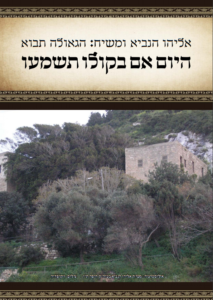By Moshe Feiglin
The Creator is the source of life. He chose the Holy Temple on the Temple Mount as His dwelling place in this world. The source of ritual impurity is death. The closer we get to G-d’s Divine Presence, the more that we must distance ourselves from death and get closer to life; distance ourselves from ritual impurity and be pure. That is why first degree ritual impurity is death, followed by lesser degrees of ritual impurity that stem from the cutting off of life on one level or another.
Immersion in a mikveh, a ritual pool, purifies from ritual impurities but not from the impurity of death. To be purified from that first degree impurity, special ritual waters are needed. These waters contain the ashes of the red heifer. This is why it is permissible to enter the Temple Mount after ritual immersion, but it is forbidden to enter the area where the Temple once stood; we do not have the ashes of the red heifer with which to purify ourselves. (This does not include entering where the Temple once stood within the framework of conquest).
When we make all the required preparations, immerse according to Jewish law and soberly ascend to the Temple Mount with non-leather shoes, as directed by halacha – we are at the closest possible point to the source of life. We carefully encircle the place where the Holy Temple once stood, leaving a wide berth of extra space to ensure that we do not step into any forbidden areas – and reach the eastern point opposite the heichal (sanctuary) of the Temple: the heichal that was and the heichal that will be.
From this point, we can view both the place where the Temple stood and the place where the priest who burned the red heifer stood, on the Mount of Olives. The priest who burned the red heifer had to retain eye contact with the Holy of Holies, because that is the place of the Foundation Stone, upon which the world is founded. If you open a map and draw a straight line from the Foundation Stone in the Holy of Holies straight eastward, you can identify the place where the red heifer was burned. Today, that place is in the courtyard of the Greek Orthodox Church on the Mount of Olives. In the courtyard lie the foundations of a mound upon which the priest stood and burned the red heifer.
The priest looked at the Shushan Gate (near today’s Gate of Rachamim) at the eastern wall of the Temple Mount. From there his gaze continued past the eastern gate of the Women’s Section that was wide open, and on to the Nikanor Gate. From there the priest continued to look on through the Israelite Section, where he saw the smoke from the sacrifices rising straight up from the altar, the priests in their service and the Levites singing their praises. From there his gaze entered the gates of the Sanctuary, itself. (All the gates were open and were in a straight line).
Inside the Sanctuary, the gaze of the priest went past the Altar of the Incense, past the Showbread Table and the Menorah and reached the Parochet that covered the entrance to the Holy of Holies.
With G-d’s help, we will speedily build our Temple – and return to life.
Shabbat Shalom.

